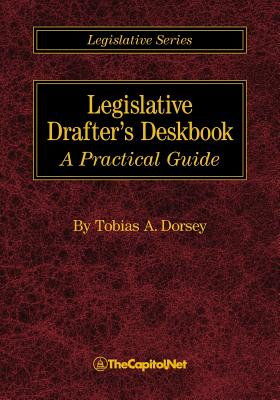You are here
Back to topLegislative Drafter's Deskbook: A Practical Guide (Paperback)
Description
The Legislative Drafter's Deskbook offers practical advice and insight for those engaged in legislative drafting, those more interested in policy than drafting itself, or those interested in reading and interpreting the law. This book explains why laws are drafted the way they are.
Legislative drafting is - to the extent it is writing at all - the form of writing used for legislative measures, a category that covers original bills and resolutions as well as amendments. Ultimately, legislative drafting is the form of writing used for enacted law. The focus of this book is on legislative drafting for the Congress of the United States, but many, if not most, of the principles described here apply just as well to drafting for other legislatures.
As forms of writing go, drafting is not freewheeling like poetry, nor showy like rhetoric, nor personal like a novel. Drafting is disciplined, rigorous, and analytical. Done well, drafting can also be creative, elegant, and clever. (Unfortunately, drafting is not always done well.)
The purpose of this book is to provide practical advice on drafting to anyone who does, or may, engage in drafting, and indirectly to provide insight into the drafting process to other interested people. For example, this book is for people who are more interested in policy than in drafting, but want to understand why drafters operate the way they do. It is also for people who are more interested in reading and interpreting the law than in drafting, but want to understand why laws are drafted the way they are. It is hoped that this book will be accessible to beginners while remaining valuable to veterans.
The traditional method of training drafters is to train them on the job; the consensus is that drafting is best learned holistically, on a case-by-case basis. For that reason this book is best used as a resource, not a course. It is a supplement to, not a substitute for, the learning that comes from experience.
The author designed this book to answer the variety of questions about drafting that arise daily in the work of individuals with a professional interest in how bills, resolutions, and laws are drafted. The approach used here is pragmatic: You will find no linguistic theories or esoteric conundrums discussed here. What you will find is solid advice for everyday drafting projects.
"A masterful work. It is comprehensive and exceptionally well written. It is an essential tool for anyone who drafts legislation or interprets the law."
-- William K. Suter, Clerk of the United States Supreme Court
"An essential and indispensable book, both as a reference work and as a thorough introduction to Federal legislative drafting."
-- Frank Burk, Legislative Counsel of the United States Senate 1991-1998
"The succinct and thorough assessment of good legislative drafting techniques provides a set of 'best practices' for drafters at all levels of government."
-- Elizabeth Garrett, Sydney M. Irmas Professor of Public Interest Law, University of Southern California
"State legislative drafters will also greatly appreciate this work."
-- Bruce Feustel, Senior Fellow, NCSL
Summary of Contents
1. Being a Drafter2. Understanding How Laws Are Made
3. Considering the Courts: Statutory Interpretation
4. Thinking Through the Policy
5. Choosing the Right Measure
6. Writing Effectively
7. Organizing and Arranging
8. Using the Right Style
9. Affecting and Amending Other Laws
10. Working in, and Working with, the Executive Branch Appendices
Back of the Book
Table of Cases
Table of Constitutional Provisions
Table of Statutes at Large
Table of Public Laws
Table of U.S. Code Sections
Index
Complete Table of Contents online at www.LegislativeDraftersDeskbook.com
